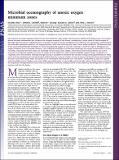Microbial oceanography of anoxic oxygen minimum zones
Author(s)
Ulloa, Osvaldo; Canfield, Don E.; DeLong, Edward; Letelier, Ricardo M.; Stewart, Frank J.
DownloadUlloa-2012-Microbial oceanography of anoxic oxygen minimum zones.pdf (1.660Mb)
PUBLISHER_POLICY
Publisher Policy
Article is made available in accordance with the publisher's policy and may be subject to US copyright law. Please refer to the publisher's site for terms of use.
Terms of use
Metadata
Show full item recordAbstract
Vast expanses of oxygen-deficient and nitrite-rich water define the major oxygen minimum zones (OMZs) of the global ocean. They support diverse microbial communities that influence the nitrogen economy of the oceans, contributing to major losses of fixed nitrogen as dinitrogen (N2) and nitrous oxide (N2O) gases. Anaerobic microbial processes, including the two pathways of N2 production, denitrification and anaerobic ammonium oxidation, are oxygen-sensitive, with some occurring only under strictly anoxic conditions. The detection limit of the usual method (Winkler titrations) for measuring dissolved oxygen in seawater, however, is much too high to distinguish low oxygen conditions from true anoxia. However, new analytical technologies are revealing vanishingly low oxygen concentrations in nitrite-rich OMZs, indicating that these OMZs are essentially anoxic marine zones (AMZs). Autonomous monitoring platforms also reveal previously unrecognized episodic intrusions of oxygen into the AMZ core, which could periodically support aerobic metabolisms in a typically anoxic environment. Although nitrogen cycling is considered to dominate the microbial ecology and biogeochemistry of AMZs, recent environmental genomics and geochemical studies show the presence of other relevant processes, particularly those associated with the sulfur and carbon cycles. AMZs correspond to an intermediate state between two “end points” represented by fully oxic systems and fully sulfidic systems. Modern and ancient AMZs and sulfidic basins are chemically and functionally related. Global change is affecting the magnitude of biogeochemical fluxes and ocean chemical inventories, leading to shifts in AMZ chemistry and biology that are likely to continue well into the future.
Date issued
2012-09Department
Massachusetts Institute of Technology. Department of Biological Engineering; Massachusetts Institute of Technology. Department of Civil and Environmental EngineeringJournal
Proceedings of the National Academy of Sciences of the United States of America
Publisher
National Academy of Sciences (U.S.)
Citation
Ulloa, O. et al. “Microbial Oceanography of Anoxic Oxygen Minimum Zones.” Proceedings of the National Academy of Sciences 109.40 (2012): 15996–16003. Web.
Version: Final published version
ISSN
0027-8424
1091-6490